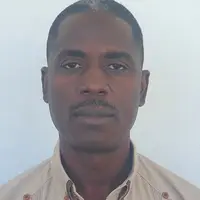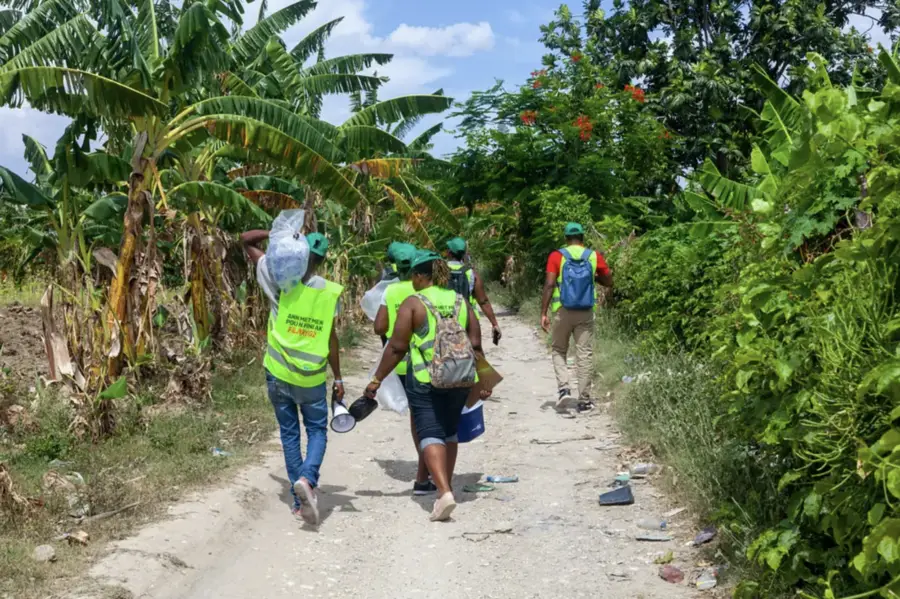Volunteers travel to farmers’ fields to administer medicine for lymphatic filariasis during Haiti’s annual LF campaign. Photo credit: RTI International/ Emmanuel Riscka Chery
This blog was originally published on Medium.
Volunteers in bright yellow vests travel door to door in rural Haiti with medicine in hand. Others sit under tents in village centers, calling out to passersby. Their target: lymphatic filariasis - a devastating and disfiguring disease spread by mosquitoes.
To eliminate lymphatic filariasis — or LF as the public health community calls it — people who live in at-risk areas must take medicine annually for at least 5 years. The medicine reduces the amount of LF parasites in a person, which makes it more difficult for mosquitoes to then spread the illness to other people.
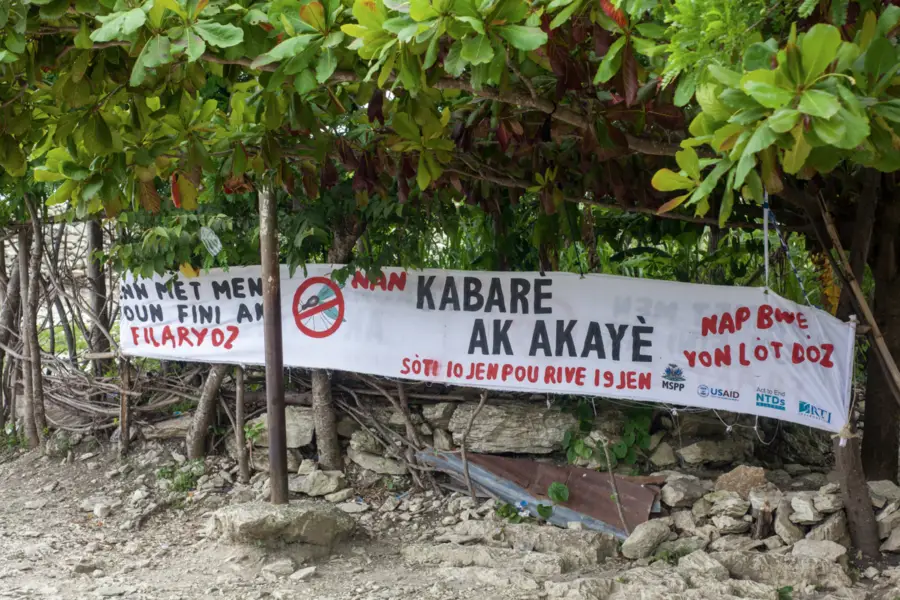
Signs announce the annual distribution of LF medicine in a commune in Haiti. Photo credit: RTI International/ Emmanuel Riscka Chery
Despite facing political unrest and natural disasters that have driven poverty up across this Caribbean country, Haiti has made great strides in eliminating LF since 2001. In fact, sixty-three percent of the population is no longer at-risk of getting this neglected tropical disease (NTD).
The challenge now is to reach the final 18 communes and people in Haiti that are still at-risk for the disease. This requires an annual mass distribution of LF medicines to more than 4.4 million people.
In December 2021, USAID’s Act to End Neglected Tropical Diseases | East Program supported Haiti’s Ministry of Public Health and Population, to gather stakeholders to review progress, challenges, and implementation of the annual LF campaign in Haiti. The government used the findings to adapt its approach to medicine distribution in an effort to advance elimination of LF in the remaining communes.
Meeting Haitians where they are at
During this year’s LF campaign, Act to End NTDs | East supported the Haitian government in implementing new and adapted methods to ensure everyone in these communes got the opportunity to take medicine. In addition to distribution posts at local points of interest like football stadiums and markets, and distribution in schools, volunteers also traveled door-to-door in the afternoons so people who worked from home, including farmers, could get medicine.
This reached people like Elinise Joseph, a farmer, seamstress, and shopkeeper who works from her home in the mountains. Last year, she happened upon a booth that was distributing lymphatic filariasis medicine while she was shopping in a larger town. This year, she benefited from door-to-door distribution.
“For me it is a good thing, a sign of love, that the agents came here to see me and give me the medicine,” Elinise said. “I am often busy here in my sewing room.”
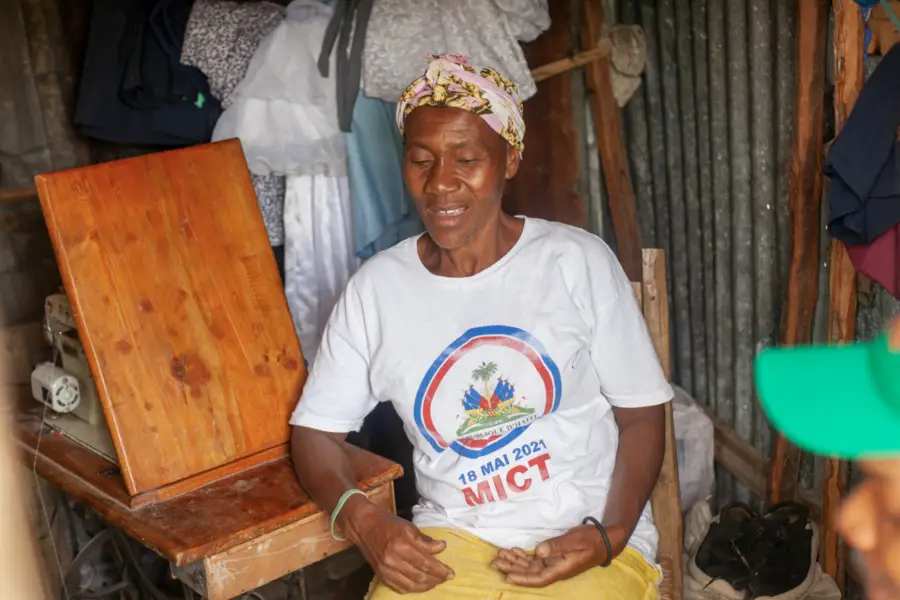
Elinise Joseph talks with door-to-door distributors in her home as she takes a break from her sewing business to receive a dose of LF medicine. Photo credit: RTI International/ Emmanuel Riscka Chery
“The door-to-door service shows your willingness to help us protect ourselves from this disease,” she continued. “This change is beneficial because there are areas here that are hard to reach.”
The government also extended distribution from 5 to ten days and Act to End NTDs | East provided badges and vests for volunteers so community members could easily pick them out of a crowd and trust that the medicine they were distributing was safe, effective, and part of a national campaign.
As a result, distribution of LF medicine reached the majority of the population in the targeted communes, helping to advance Haiti’s progress to eliminate LF.
Overcoming skepticism and reluctance
In reviewing past LF campaigns, Act to End NTDs | East found that young men and other youth were less likely to have taken medicine for LF. They often considered themselves to be too cool or invincible to need it — a common attitude among youth in many countries.
To address this, the 2022 distribution campaign engaged local youth associations, leaders, and influencers in microplanning (early and targeted planning, usually at a very local level) as well as in communications and outreach campaigns before and during distribution.
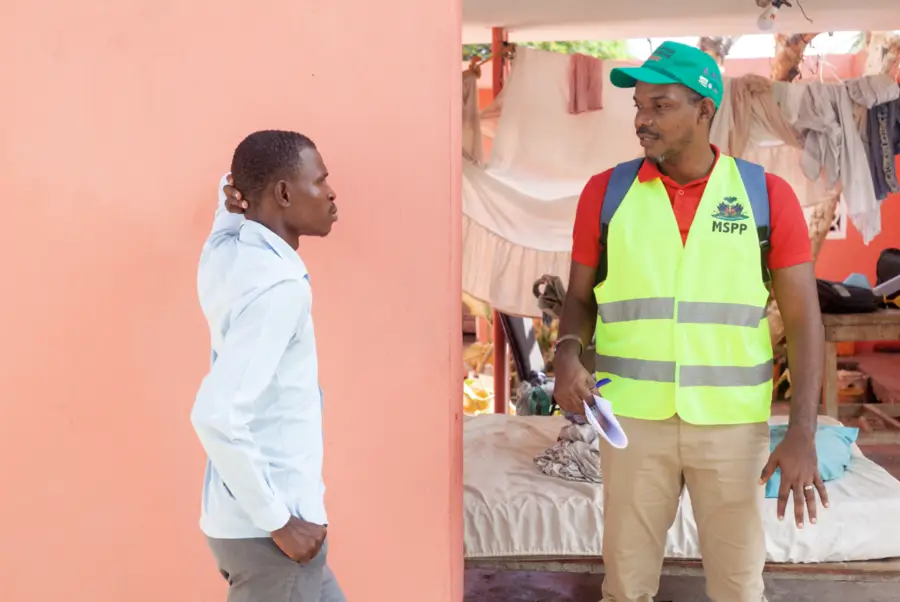
A young man talks with Jonathan Sylveste, an Act to End NTDs | East Program staff member about LF and decides to take a dose of medicine. Photo credit: RTI International/ Emmanuel Riscka Chery
Communications focused on educating young men on the devastating impacts of LF, which include visible disfigurement (known as elephantiasis), as well as the less visible complications, such as impacts to a person’s immune system and kidneys. Special ads and messaging were developed to speak directly to young men’s concerns and motivations; and the Ministry of Public Health and Population trained distributors on how to address the questions — and skepticism — they expected youth to have.
These efforts convinced young men like Duclervil Davidson, a father and musician, to take LF medicine for the first time. Curiosity drew him to the booth this year. “I was always reluctant [in the past] because I don’t like to take medicine,” he said. “What convinced me this year were the [distributors]. They spoke to me in a way that made it clear why it was important to take the medicine.”
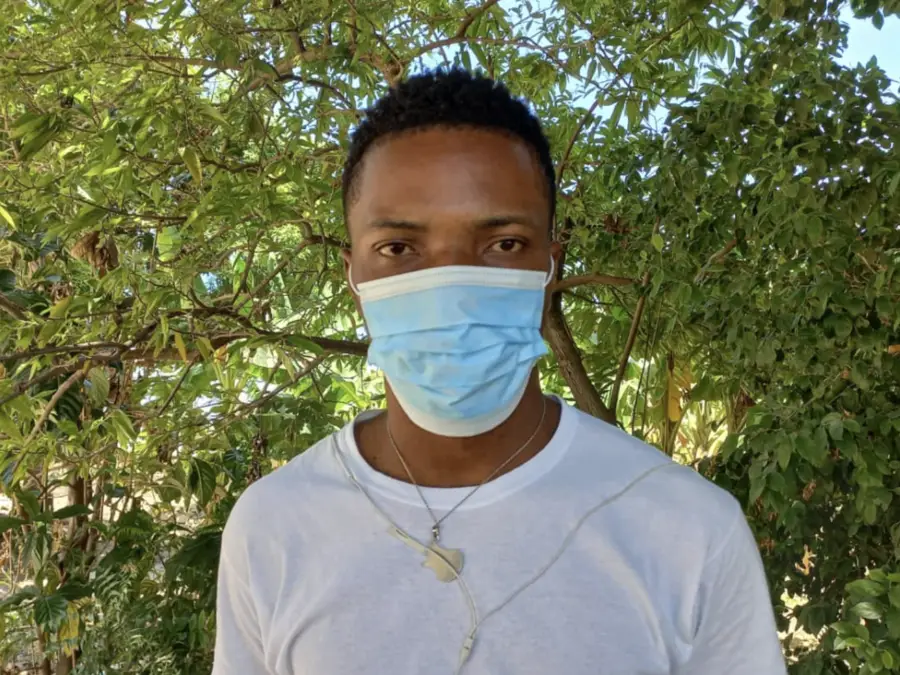
Duclervil Davidson poses for a photograph after receiving a dose of LF medication for the first time during an annual LF campaign in 2022. Photo credit: RTI International/Jonathan Sylveste.
Davidson realized that the distributors had his interests in mind, and that it was for his own good to take the medicine and protect himself. This conversation and new understanding helped him overcome his reluctance and become a supporter of LF elimination.
“Good health is what safeguards the life of a community,” he said. “You can’t have a good life without good health. So, it is up to us to…take these medicines to ensure that we are protected against filariasis.”
Building local systems
Elimination of LF in Haiti ultimately depends on the leadership of governments and communities throughout the country. Local leaders like Carole Molière are a critical part of elimination efforts.
Carole is well loved in her community and has worked for the Haitian Ministry of Public Health and Population for over 30 years. She has supported national efforts to eliminate LF since they began in 2001, raising awareness about LF and supervising annual medicine distribution in her community.
“I do not like to see a person in the community, either a girl or a boy, with big feet,” she said of the effects of LF. “It is true that the disease does not kill you immediately, but it does exclude you from society. Not to mention the psychological effects.”
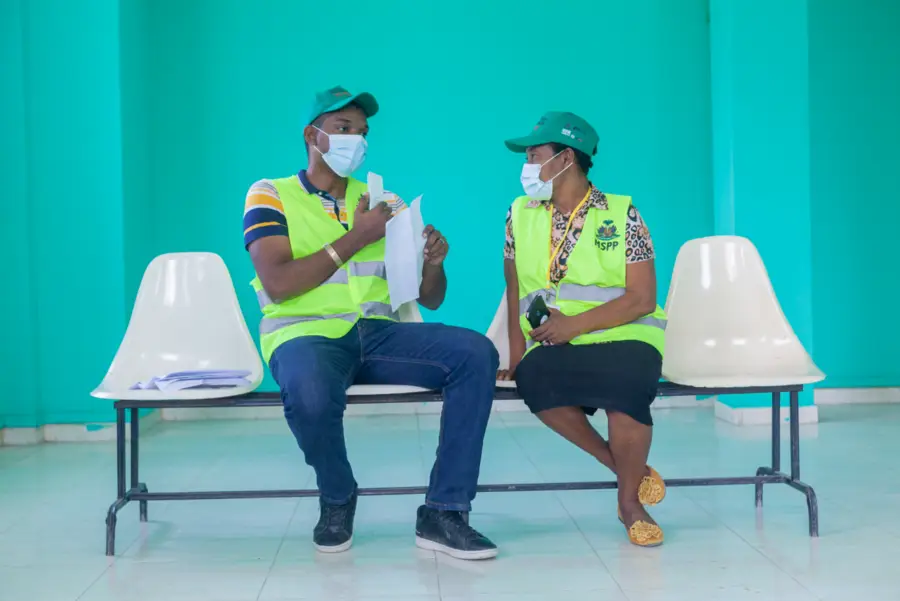
Carole Molière, a long-term supporter of LF elimination effortsin Haiti, talks with Jonathan Sylveste, an RTI staff member during the annual LF campaign. Photo credit: RTI International/ Emmanuel Riscka Chery
She was enthusiastic about the changes in the LF campaign this year, including the provision of snacks with the medicine. “With the sweets we have noticed that there is more motivation to take the tablets,” she said.
Act to End NTDs | East supports and works through the government of Haiti — from the central Ministry of Public Health and Population to district and commune-level entities — to plan, conduct, and evaluate distribution campaigns like the one in 2022. In doing so, it helps to build the long-term capacity of the government to effectively eliminate NTDs like LF. The distribution campaigns source volunteers from local communities as well, with volunteers often participating year-after-year under supervision from the Ministry of Public Health and Population.
As a result, Haiti has continued to make strides in eliminating LF even as it faces worsening political upheaval, gang violence, and environmental disasters. The long-term commitment born of local volunteers and supporters has made this possible. “There is still hope that one day filariasis will be eliminated here,” Carole said.
Toward elimination
Haiti’s goal is to eliminate LF by 2030. By learning from what’s working and what isn’t, and by trying new approaches based in evidence and learning, the USAID Act to End NTDs | East Program is helping the country achieve this goal. Since 2008, USAID has distributed LF medicine to 9 million Haitians — nearly 76% of the population.
The Haitian Ministry of Public Health and Population continues to monitor and track progress across all communes, to ensure the disease is eliminated for good. While 2030 fast approaches, Haiti — with the help of partners like USAID — is moving closer to the day when all Haitians are free from this disabling disease.
About Act to End NTDs | East
USAID’s Act to End NTDs | East is a global flagship program working to eliminate neglected tropical diseases in 12 countries in Africa, Asia, and Latin America. With USAID support, Act to End NTDs | East works with health ministries to treat communities, measure progress, and strengthen health systems to deliver NTD services.
Learn more about RTI’s efforts in the elimination of neglected tropical diseases.

